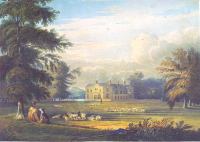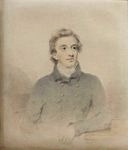Alfred Garret Foster-Barham (*1829)
|
Page AS III.5 to overview
|
Joseph
Foster (Barham)
* 16-12-1729 Jamaica
+ 21-07-1789
Hardwicke Hall, Shropshire |
Dorothea Vaughan
* 26-03-1721 Pembrokeshire, Wales
+ 26-09-1781
Bedford, Camb. |
x
01-07-1754 Cheltenham, Gloucest. |
|
Joshua Morton
*
+
(Reverend) |
nn
*
+ |
x |
|
|
|
Thomas Barham Foster-Barham
*
08-10-1766
+ 25-02-1844 Penzance, Cornwall
(Writer, Composer) |
Mary Ann Morton
* ~1768
+
1838 Penzance |
x ~1790 |
|
|
Thomas Foster-Barham
* 1794
Hendon, Middlesex
+ 03-03-1869 Devon
(Medical doctor) |
Sarah Garrett
*
+ 22-10-1836 |
x |
|
Alfred Garret Foster-Barham
* 1829 Exeter, Devon
+ 1901 Bridgwater, Somerset 1854 x Eliza Jevons |
Joseph and Dorothea
Joseph was born in west Jamaica as Foster,
but later took the name of his stepfather Barham.
In records he appears under all three family names.
Joseph inherited large estates in Jamaica.
He ultimately lived in Hardwicke Hall, Shropshire
(image: Hardwicke Hall as painted in the 19th century by John Homes Smith).
Dorothea was entitled to the Trecwn estates in Pembrokeshire.
[ Information from Welsh Biography, Online:
Barham family, of Trecwn, Pembrokeshire.
On 1 July 1754 at Cheltenham, Dorothea, fourth daughter of John
Vaughan of Trecwn and Joan Corbet his wife, married Joseph
Foster-Barham, son of Colonel John Foster (1681-1731), of Egham
House, Surrey, and Jamaica. He was b. 16 Dec. 1729 in Jamaica,
where the family had large estates which he inherited. He assumed
the surname of his step-father, Dr. Henry Barham, in 1750, and
died in 1789. ]
From the website on the life of daughter Martha (1760-1789):
Joseph Foster Barham was a prominent Moravian lay-person and wealthy
Jamaican planter who had inherited both his name and the Jamaican estate
of Mesopotamia in western Jamaica from his step-father, Henry Barham.
Bedford (Bedfordshire) was one of the most important centers for the
Moravians in England and Foster Barham was instrumental in
establishing the Moravian Church in Jamaica in 1754, especially
among the slave population. Foster Barham himself owned over 200
slaves and, though he did not free them, he did work to improve
living conditions for slaves on his own plantation.
For more on the Moravians and the Foster Barhams, see with Josephs father.
Children: 1755 Elizabeth Dorothea, 1756 Anna Johanna, 1757 Mary,
1759 Joseph (succeeded in the Trecwn estates),
1760 Martha, 1763 John Barham,
1766 Thomas Barham, 1771 Sarah, 1773 Mary Helden.
Dorothea died in 1781.
Thomas then married Lady Mary Pole in 1785.
Both died in 1789 in Hardwicke Hall, Shropshire (see painting),
the house of the Kynaston family.
[ Later, son and heir Joseph Foster Barham II (1759-1832) was
directly involved in the debates over the abolition of slavery as a
Member of Parliament, arguing for a more gradual process of abolition
rather than an outright ban (debates as of the late 1780s).
In this (moderate) support for the slave
trade the Barham's stood at odds with the majority of the evangelical
movement in England at the time, with such noted evangelicals as John
Wesley, Hannah More, and William Wilberforce calling for the outright
abolition of both the slave trade and slavery. In 1818,
Joseph Foster Barham owned on the estate Mesopotamia (Parish Westmoreland,
County Cornwall, Jamaica) 317 slaves and 355 cattle
(see Proprietors etc., Properties, Slaves/Stock),
in 1831 there were 332 slaves and 239 cattle. Slave trade was abolished
in 1833, the slave owners were financially compensated. ]

|
Thomas and Mary Ann
Thomas was writer and composer.
Ann was the eldest daughter of Rev. Joshua Morton.
Children: NN, 1794 Thomas, NN, 1796 Henry, 1802 William,
1804, Charles, Emily, 1808 Francis (known as Alist).
The photo of the memorial monument at St. Mary Churchyard,
Penzance, Cornwall, is from "findagrave.com".
Thomas and Sarah
Thomas was doctor.
He got his degree in 1820 at Queen's College, University of Cambridge,
Cambridge. After that he returned to Cornwall.
The portrait is of unknown date.
Children (most born in Penzance, Cornwall):
1819 Henry, 1819 William, 1821 Mary (+1862) and Eliza (+1862),
1823 Ellen, 1824 Emily,
1825 Eustace (x Ellen Huare),
1828 Charles, 1829 Alfred, 1831 Sophie, 1835 Martha, 1836 Joseph.
Sarah died and Thomas then married Margaret Henryson.
They then got one child, 1843 Alkman Henryson Barham.
Thomas died in 1869 and was buried in the
Parish Church of All Saints, Highweek, Devon.
Most data are taken from Genealogy Foster-Barham
See also "A genealogical and heraldic history of the landed gentry of Great Britain & Ireland".
(2017.04.12)



